中国文化通览
- 格式:doc
- 大小:147.00 KB
- 文档页数:17
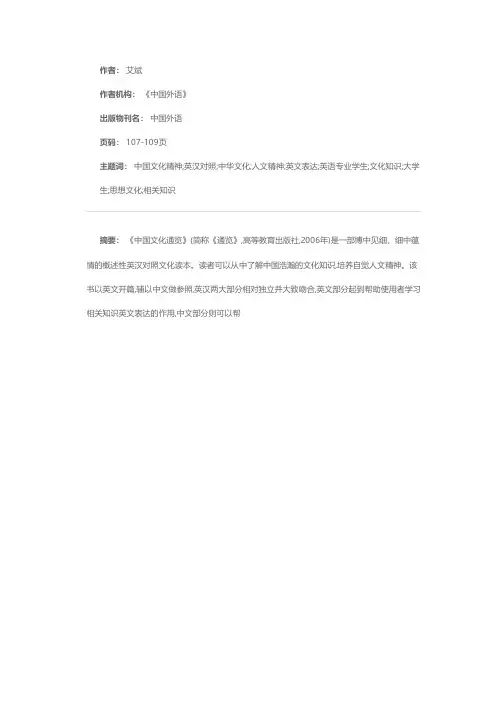
作者: 艾斌
作者机构: 《中国外语》
出版物刊名: 中国外语
页码: 107-109页
主题词: 中国文化精神;英汉对照;中华文化;人文精神;英文表达;英语专业学生;文化知识;大学生;思想文化;相关知识
摘要: 《中国文化通览》(简称《通览》,高等教育出版社,2006年)是一部博中见细、细中蕴情的概述性英汉对照文化读本。
读者可以从中了解中国浩瀚的文化知识,培养自觉人文精神。
该书以英文开篇,辅以中文做参照,英汉两大部分相对独立并大致吻合,英文部分起到帮助使用者学习相关知识英文表达的作用,中文部分则可以帮。
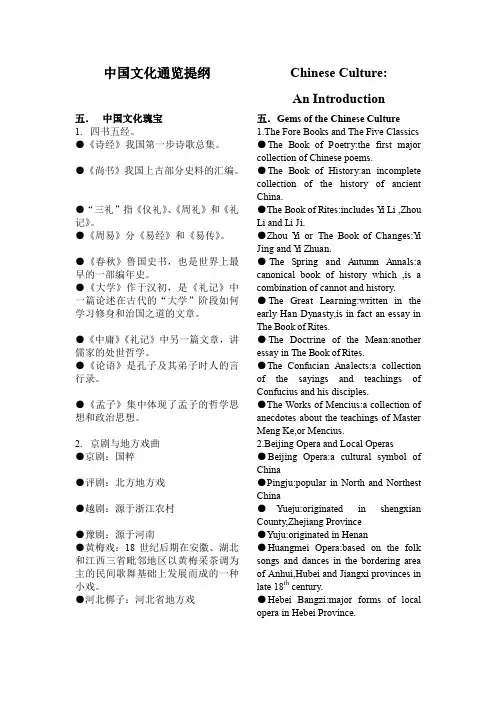
中国文化通览提纲五.中国文化瑰宝1.四书五经。
●《诗经》我国第一步诗歌总集。
●《尚书》我国上古部分史料的汇编。
●“三礼”指《仪礼》、《周礼》和《礼记》。
●《周易》分《易经》和《易传》。
●《春秋》鲁国史书,也是世界上最早的一部编年史。
●《大学》作于汉初,是《礼记》中一篇论述在古代的“大学”阶段如何学习修身和治国之道的文章。
●《中庸》《礼记》中另一篇文章,讲儒家的处世哲学。
●《论语》是孔子及其弟子时人的言行录。
●《孟子》集中体现了孟子的哲学思想和政治思想。
2.京剧与地方戏曲●京剧:国粹●评剧:北方地方戏●越剧:源于浙江农村●豫剧:源于河南●黄梅戏:18世纪后期在安徽、湖北和江西三省毗邻地区以黄梅采茶调为主的民间歌舞基础上发展而成的一种小戏。
●河北梆子:河北省地方戏Chinese Culture:An Introduction五.Gems of the Chinese Culture1.The Fore Books and The Five Classics●The Book of Poetry:the first major collection of Chinese poems.●The Book of History:an incomplete collection of the history of ancient China.●The Book of Rites:includes Yi Li ,Zhou Li and Li Ji.●Zhou Yi or The Book of Changes:Yi Jing and Yi Zhuan.●The Spring and Autumn Annals:a canonical book of history which ,is a combination of cannot and history.●The Great Learning:written in the early Han Dynasty,is in fact an essay in The Book of Rites.●The Doctrine of the Mean:another essay in The Book of Rites.●The Confucian Analects:a collection of the sayings and teachings of Confucius and his disciples.●The Works of Mencius:a collection of anecdotes about the teachings of Master Meng Ke,or Mencius.2.Beijing Opera and Local Operas●Beijing Opera:a cultural symbol of China●Pingju:popular in North and Northest China●Yueju:originated in shengxian County,Zhejiang Province●Yuju:originated in Henan●Huangmei Opera:based on the folk songs and dances in the bordering area of Anhui,Hubei and Jiangxi provinces in late 18th century.●Hebei Bangzi:major forms of local opera in Hebei Province.●吕剧:山东省地方戏●川剧:西南几省的地方戏3.中国书画●中国传统人物画:人物活动为只要描写对象●中国传统山水画:自然风景为只要描写对象●中国传统花鸟画:动植物为只要描写对象●中国书法:中国特有的具有悠久历史和民族特色的传统艺术4.生活中的文化符号文房四宝:笔、墨、纸、砚●中国对联:俗称对子,是我国一种独特的文学艺术形式●中国印章:即玺印篆刻,是依附于书法而又具有相对独立性的一种传统艺术形式六.中国民间艺术与竞技1.民间工艺木版年画,剪纸,风筝,刺绣,纺织,印染,陶瓷,金银玉器,竹木藤器,泥塑。
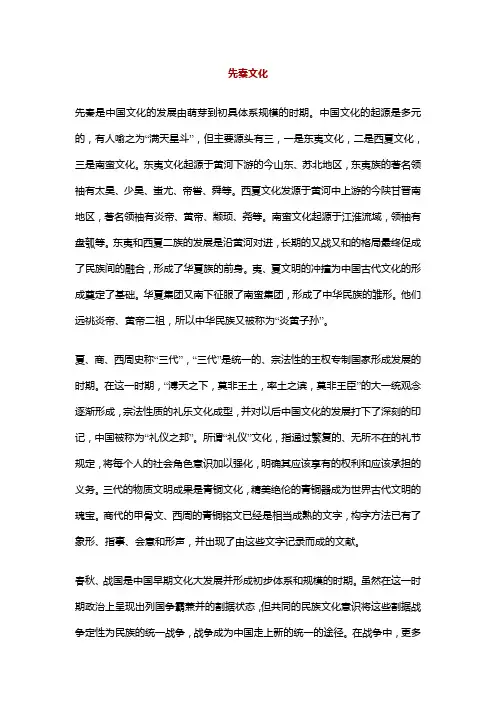
先秦文化先秦是中国文化的发展由萌芽到初具体系规模的时期。
中国文化的起源是多元的,有人喻之为“满天星斗”,但主要源头有三,一是东夷文化,二是西夏文化,三是南蛮文化。
东夷文化起源于黄河下游的今山东、苏北地区,东夷族的著名领袖有太昊、少昊、蚩尤、帝喾、舜等。
西夏文化发源于黄河中上游的今陕甘晋南地区,著名领袖有炎帝、黄帝、颛顼、尧等。
南蛮文化起源于江淮流域,领袖有盘瓠等。
东夷和西夏二族的发展是沿黄河对进,长期的又战又和的格局最终促成了民族间的融合,形成了华夏族的前身。
夷、夏文明的冲撞为中国古代文化的形成奠定了基础。
华夏集团又南下征服了南蛮集团,形成了中华民族的雏形。
他们远祧炎帝、黄帝二祖,所以中华民族又被称为“炎黄子孙”。
夏、商、西周史称“三代”,“三代”是统一的、宗法性的王权专制国家形成发展的时期。
在这一时期,“溥天之下,莫非王土,率土之滨,莫非王臣”的大一统观念逐渐形成,宗法性质的礼乐文化成型,并对以后中国文化的发展打下了深刻的印记,中国被称为“礼仪之邦”。
所谓“礼仪”文化,指通过繁复的、无所不在的礼节规定,将每个人的社会角色意识加以强化,明确其应该享有的权利和应该承担的义务。
三代的物质文明成果是青铜文化,精美绝伦的青铜器成为世界古代文明的瑰宝。
商代的甲骨文、西周的青铜铭文已经是相当成熟的文字,构字方法已有了象形、指事、会意和形声,并出现了由这些文字记录而成的文献。
春秋、战国是中国早期文化大发展并形成初步体系和规模的时期。
虽然在这一时期政治上呈现出列国争霸兼并的割据状态,但共同的民族文化意识将这些割据战争定性为民族的统一战争,战争成为中国走上新的统一的途径。
在战争中,更多的部族国家参与进来,促进了更大范围的文化融合,从而为秦汉统一的封建大帝国的建立打下了基础。
与政治上的割据状态相适应的是思想领域“百家争鸣”的局面。
春秋末年孔子首创私学,打破了“学在官府”的学术垄断,建立了儒家学派。
孔子是中国文化继往开来的伟大人物,他整理了夏商周“三代”的文化成果“五经”,即《诗》、《书》、《礼》、《易》、《春秋》,又创立了“礼”和“仁”结合的思想体系,开辟了中国思想文化的新局面。
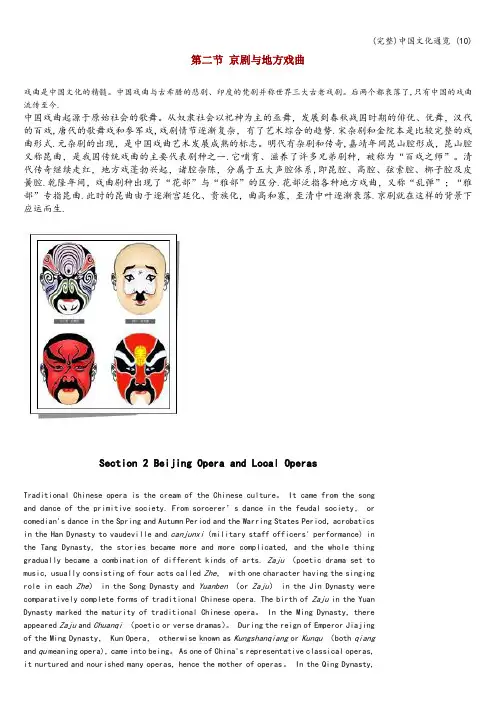
第二节京剧与地方戏曲戏曲是中国文化的精髓。
中国戏曲与古希腊的悲剧、印度的梵剧并称世界三大古老戏剧。
后两个都衰落了,只有中国的戏曲流传至今.中国戏曲起源于原始社会的歌舞。
从奴隶社会以祀神为主的巫舞,发展到春秋战国时期的俳优、优舞,汉代的百戏,唐代的歌舞戏和参军戏,戏剧情节逐渐复杂,有了艺术综合的趋势.宋杂剧和金院本是比较完整的戏曲形式.元杂剧的出现,是中国戏曲艺术发展成熟的标志。
明代有杂剧和传奇,嘉靖年间昆山腔形成,昆山腔又称昆曲,是我国传统戏曲的主要代表剧种之一.它哺育、滋养了许多兄弟剧种,被称为“百戏之师”。
清代传奇继续走红,地方戏蓬勃兴起,诸腔杂陈,分属于五大声腔体系,即昆腔、高腔、弦索腔、梆子腔及皮簧腔.乾隆年间,戏曲剧种出现了“花部”与“雅部”的区分.花部泛指各种地方戏曲,又称“乱弹”;“雅部”专指昆曲.此时的昆曲由于逐渐宫廷化、贵族化,曲高和寡,至清中叶逐渐衰落.京剧就在这样的背景下应运而生.Section 2 Beijing Opera and Local OperasTraditional Chinese opera is the cream of the Chinese culture。
It came from the songand dance of the primitive society. From sorcerer’s dance in the feudal society, orcomedian's dance in the Spring and Autumn Period and the Warring States Period, acrobaticsin the Han Dynasty to vaudeville and canjunxi(military staff officers' performance) inthe Tang Dynasty, the stories became more and more complicated, and the whole thinggradually became a combination of different kinds of arts. Zaju(poetic drama set tomusic, usually consisting of four acts called Zhe, with one character having the singingrole in each Zhe) in the Song Dynasty and Yuanben(or Zaju) in the Jin Dynasty werecomparatively complete forms of traditional Chinese opera. The birth of Zaju in the YuanDynasty marked the maturity of traditional Chinese opera。
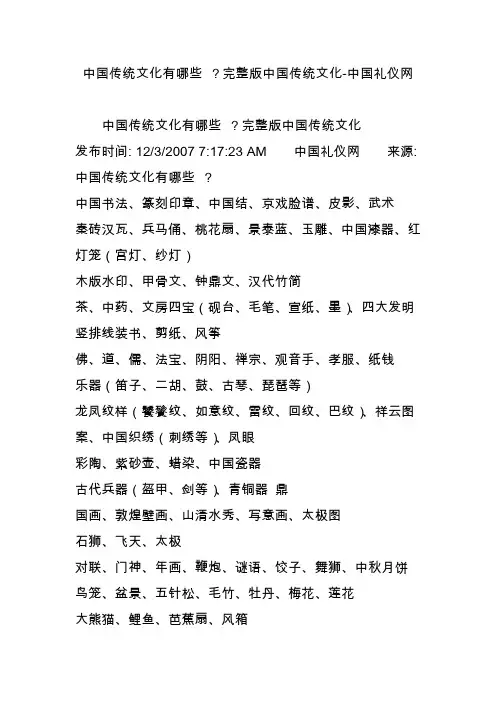
中国传统文化有哪些?完整版中国传统文化-中国礼仪网中国传统文化有哪些?完整版中国传统文化发布时间: 12/3/2007 7:17:23 AM 中国礼仪网来源: 中国传统文化有哪些?中国书法、篆刻印章、中国结、京戏脸谱、皮影、武术秦砖汉瓦、兵马俑、桃花扇、景泰蓝、玉雕、中国漆器、红灯笼(宫灯、纱灯)木版水印、甲骨文、钟鼎文、汉代竹简茶、中药、文房四宝(砚台、毛笔、宣纸、墨)、四大发明竖排线装书、剪纸、风筝佛、道、儒、法宝、阴阳、禅宗、观音手、孝服、纸钱乐器(笛子、二胡、鼓、古琴、琵琶等)龙凤纹样(饕餮纹、如意纹、雷纹、回纹、巴纹)、祥云图案、中国织绣(刺绣等)、凤眼彩陶、紫砂壶、蜡染、中国瓷器古代兵器(盔甲、剑等)、青铜器鼎国画、敦煌壁画、山清水秀、写意画、太极图石狮、飞天、太极对联、门神、年画、鞭炮、谜语、饺子、舞狮、中秋月饼鸟笼、盆景、五针松、毛竹、牡丹、梅花、莲花大熊猫、鲤鱼、芭蕉扇、风箱黑头发黄皮肤、丹凤眼红旗、天安门、五角星、红领巾、红太阳、长江、黄河唐装、绣花鞋、老虎头鞋、旗袍、肚兜、斗笠、帝王的皇冠、皇后的凤冠泥人面塑、锄头、清朝大辫子、铜镜、大花轿、水烟袋、鼻烟壶、筷子华表、牌坊、长城、园林、寺院、古钟、古塔、庙宇、亭、井、黄土、民宅汉字、数字8、6、4唐诗、宋词、《三十六计》、《孙子兵法》、《西游记》、《红楼梦》、《三国演义》、《水浒传》、《诗经》金元宝、如意、烛台、罗盘、八卦、司南、棋子与棋盘、象棋、围棋黄包车、鼻烟壶、鸟笼、长命锁、糖葫芦玉佩、鹫、千层底、刺绣、丝绸、檐另外我国有各种各样的传统节日,很多事情有各种礼仪和习俗……每个地方还有地方和民族的特色。
责任编辑:。
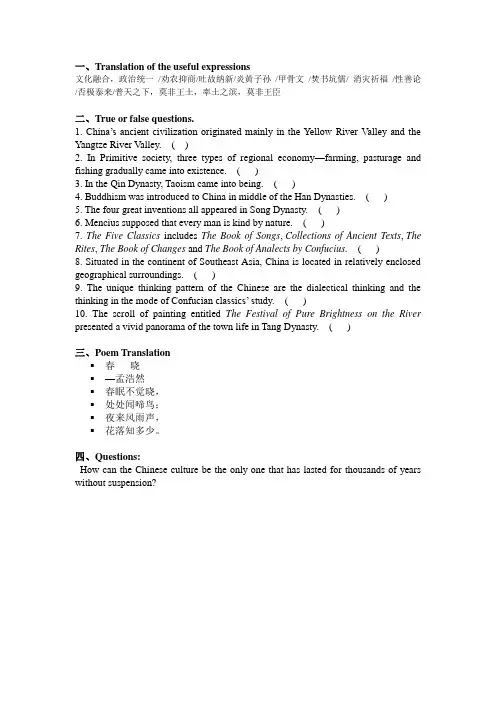
一、Translation of the useful expressions文化融合,政治统一/劝农抑商/吐故纳新/炎黄子孙/甲骨文/焚书坑儒/ 消灾祈福/性善论/否极泰来/普天之下,莫非王土,率土之滨,莫非王臣二、True or false questions.1. China’s ancient civilization originated mainly in the Yellow River Valley and the Yangtze River Valley. ( )2. In Primitive society, three types of regional economy—farming, pasturage and fishing gradually came into existence. ( )3. In the Qin Dynasty, Taoism came into being. ( )4. Buddhism was introduced to China in middle of the Han Dynasties. ( )5. The four great inventions all appeared in Song Dynasty. ( )6. Mencius supposed that every man is kind by nature. ( )7. The Five Classics includes The Book of Songs, Collections of Ancient Texts, The Rites, The Book of Changes and The Book of Analects by Confucius. ( )8. Situated in the continent of Southeast Asia, China is located in relatively enclosed geographical surroundings. ( )9. The unique thinking pattern of the Chinese are the dialectical thinking and the thinking in the mode of Confucian classics’ study. ( )10. The scroll of painting entitled The Festival of Pure Brightness on the River presented a vivid panorama of the town life in Tang Dynasty. ( )三、Poem Translation▪春晓▪—孟浩然▪春眠不觉晓,▪处处闻啼鸟;▪夜来风雨声,▪花落知多少。
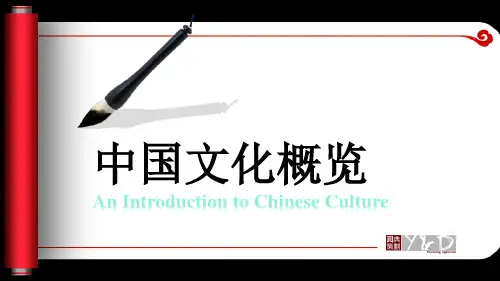
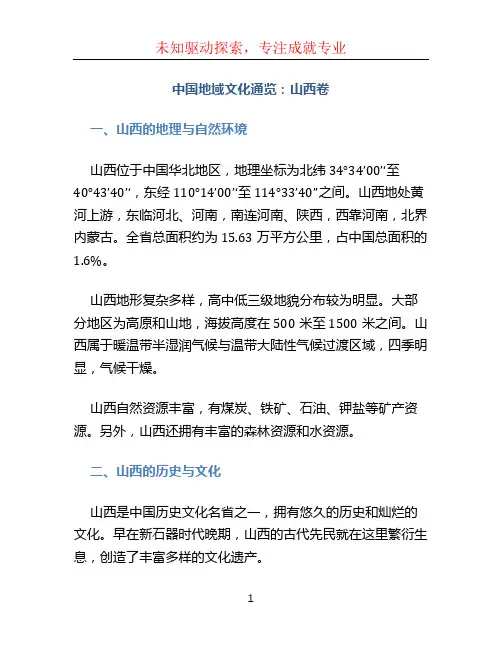
中国地域文化通览:山西卷一、山西的地理与自然环境山西位于中国华北地区,地理坐标为北纬34°34’00’‘至40°43’40’‘,东经110°14’00’‘至114°33’40’’之间。
山西地处黄河上游,东临河北、河南,南连河南、陕西,西靠河南,北界内蒙古。
全省总面积约为15.63万平方公里,占中国总面积的1.6%。
山西地形复杂多样,高中低三级地貌分布较为明显。
大部分地区为高原和山地,海拔高度在500米至1500米之间。
山西属于暖温带半湿润气候与温带大陆性气候过渡区域,四季明显,气候干燥。
山西自然资源丰富,有煤炭、铁矿、石油、钾盐等矿产资源。
另外,山西还拥有丰富的森林资源和水资源。
二、山西的历史与文化山西是中国历史文化名省之一,拥有悠久的历史和灿烂的文化。
早在新石器时代晚期,山西的古代先民就在这里繁衍生息,创造了丰富多样的文化遗产。
山西是中国古代文明的发祥地之一,有着丰富的历史遗存。
山西是中华民族的摇篮,是中国封建文化的发源地,这里孕育了众多的文化名人和历史名人。
山西的文化遗产丰富多样,有大量的古建筑、文物、艺术品等。
代表性的古建筑有山西的古城墙、古寺庙、古民居等,代表性的文物有山西的青铜器、玉器、书画等。
山西还有独特的民俗文化,如山西的传统节日、传统习俗、传统美食等,具有浓郁的地方特色。
三、山西的艺术与文学山西是中国传统文学与艺术发达的地区之一。
山西有悠久的戏曲传统,著名的有晋剧、梆子等。
山西还有丰富多样的曲艺,如山西的评话、相声等。
山西的文学创作也有着重要的地位,有许多文学名家出自山西。
山西的文学作品体现了浓厚的地方风情和优秀的艺术品质。
山西还是中国国粹太极拳的发祥地之一,山西的太极拳有着悠久的历史,博大精深的太极文化,对世界太极拳的影响深远。
四、山西的旅游资源与特色山西的旅游资源丰富多样,有着许多著名的旅游景点和文化遗址。
其中,最著名的旅游景点包括:五台山、平遥古城、大同云冈石窟、山西博物院等。
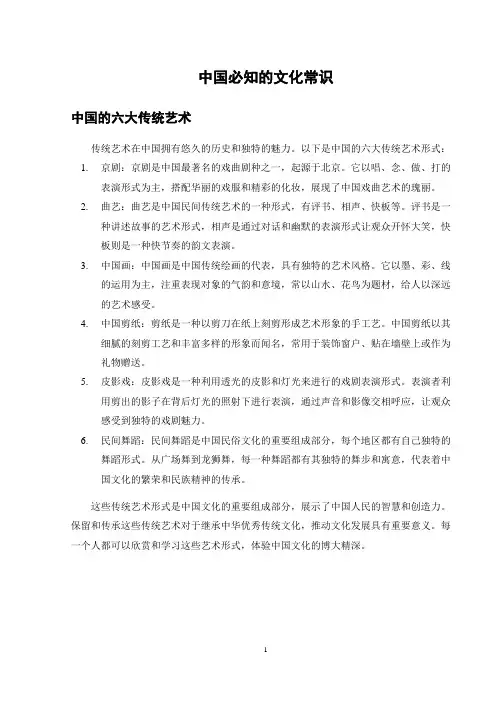
中国必知的文化常识
中国的六大传统艺术
传统艺术在中国拥有悠久的历史和独特的魅力。
以下是中国的六大传统艺术形式:1.京剧:京剧是中国最著名的戏曲剧种之一,起源于北京。
它以唱、念、做、打的
表演形式为主,搭配华丽的戏服和精彩的化妆,展现了中国戏曲艺术的瑰丽。
2.曲艺:曲艺是中国民间传统艺术的一种形式,有评书、相声、快板等。
评书是一
种讲述故事的艺术形式,相声是通过对话和幽默的表演形式让观众开怀大笑,快板则是一种快节奏的韵文表演。
3.中国画:中国画是中国传统绘画的代表,具有独特的艺术风格。
它以墨、彩、线
的运用为主,注重表现对象的气韵和意境,常以山水、花鸟为题材,给人以深远的艺术感受。
4.中国剪纸:剪纸是一种以剪刀在纸上刻剪形成艺术形象的手工艺。
中国剪纸以其
细腻的刻剪工艺和丰富多样的形象而闻名,常用于装饰窗户、贴在墙壁上或作为礼物赠送。
5.皮影戏:皮影戏是一种利用透光的皮影和灯光来进行的戏剧表演形式。
表演者利
用剪出的影子在背后灯光的照射下进行表演,通过声音和影像交相呼应,让观众感受到独特的戏剧魅力。
6.民间舞蹈:民间舞蹈是中国民俗文化的重要组成部分,每个地区都有自己独特的
舞蹈形式。
从广场舞到龙狮舞,每一种舞蹈都有其独特的舞步和寓意,代表着中国文化的繁荣和民族精神的传承。
这些传统艺术形式是中国文化的重要组成部分,展示了中国人民的智慧和创造力。
保留和传承这些传统艺术对于继承中华优秀传统文化,推动文化发展具有重要意义。
每一个人都可以欣赏和学习这些艺术形式,体验中国文化的博大精深。
1。
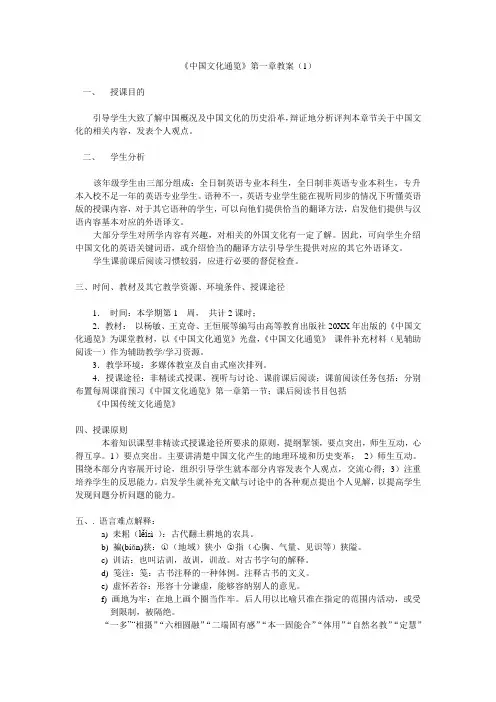
《中国文化通览》第一章教案(1)一、授课目的引导学生大致了解中国概况及中国文化的历史沿革,辩证地分析评判本章节关于中国文化的相关内容,发表个人观点。
二、学生分析该年级学生由三部分组成:全日制英语专业本科生,全日制非英语专业本科生,专升本入校不足一年的英语专业学生。
语种不一,英语专业学生能在视听同步的情况下听懂英语版的授课内容,对于其它语种的学生,可以向他们提供恰当的翻译方法,启发他们提供与汉语内容基本对应的外语译文。
大部分学生对所学内容有兴趣,对相关的外国文化有一定了解。
因此,可向学生介绍中国文化的英语关键词语,或介绍恰当的翻译方法引导学生提供对应的其它外语译文。
学生课前课后阅读习惯较弱,应进行必要的督促检查。
三、时间、教材及其它教学资源、环境条件、授课途径1.时间:本学期第1 周,共计2课时;2.教材:以杨敏、王克奇、王恒展等编写由高等教育出版社20XX年出版的《中国文化通览》为课堂教材,以《中国文化通览》光盘,《中国文化通览》课件补充材料(见辅助阅读一)作为辅助教学/学习资源。
3.教学环境:多媒体教室及自由式座次排列。
4.授课途径:非精读式授课、视听与讨论、课前课后阅读;课前阅读任务包括:分别布置每周课前预习《中国文化通览》第一章第一节;课后阅读书目包括《中国传统文化通览》四、授课原则本着知识课型非精读式授课途径所要求的原则,提纲挈领,要点突出,师生互动,心得互享。
1)要点突出。
主要讲清楚中国文化产生的地理环境和历史变革;2)师生互动。
围绕本部分内容展开讨论,组织引导学生就本部分内容发表个人观点,交流心得;3)注重培养学生的反思能力。
启发学生就补充文献与讨论中的各种观点提出个人见解,以提高学生发现问题分析问题的能力。
五、. 语言难点解释:a) 耒耜(lěi sì):古代翻土耕地的农具。
b) 褊(biǎn)狭:○1(地域)狭小○2指(心胸、气量、见识等)狭隘。
c) 训诂:也叫诂训,故训,训故。
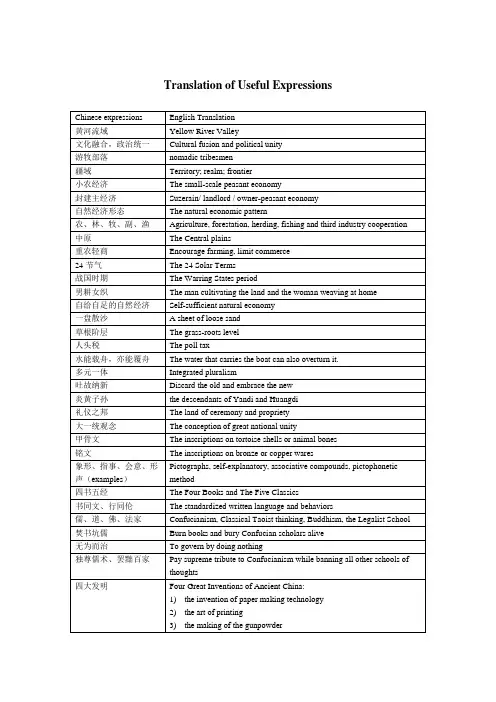
Translation of Useful Expressions课堂重点1) The Four Books (The Great Learning , The Doctrine of the Mean , The Confucian Analects , and The Works of Mencius ) and The Five Classics (The Book of Poetry , The Book of History , The Book of Rites , The Book of Changes , and The Spring and Autumn Annals ) cover a wide range of subjectsand are the most important textbooks for the Confucian scholars to disseminate the educational thoughts of the Confucian School and a must for ancient scholars who had to pass the imperial competitive examination to become government officials.2) The Great Learning is about the cultivation of one’s moral character and the wisdoms of governing a country during the “daxue”(or great learning or higher education) period of ancient China.3) The Confucian Analects or The Analects embodies the Confucian concept of ren or humanity or benevolence, and another concept of yi or righteousness.4) The Works of Mencius embodies the philosophical and political thinking of Mencius. He developed and enriched the “ren and yi theory”of Confucius and supposed that every man is good by nature, and called for a benevolent government.5) The Book of History is an incomplete collection of the history of ancient China. It is an invaluable reference for the study of the primitive and feudal societies in ancient China and is the source of narrative writing in China as well. This book consists of three parts:the exhortations, oaths or declarations by the lords to their subjects; the advice or suggestions of the subjects to their lord; folklores or other materials6) The Spring and Autumn Annals is a canonical book of history. It consists of three Commentaries: the Commentary of Zuo focuses on history; the Commentaries of Gongyang and Guliang concentrate on comments on historical events.7) Beijing Opera emerged in Qing Dynasty, when Kun opera was gradually on the wane because it was only enjoyed by the nobles in the royal court, not the general public. It is a treasure of the Chinese nation as well as a cultural symbol of China, and is enjoyed by a large Chinese audience.8) Classification of Beijing Opera9)Figure painting is the earliest kind of traditional Chinese painting; It reflects to a great degree aesthetic and artistic thinking of Confucian scholars, with the aim to rectify one’s mind and make people abstain from their desires. It is divided into five major categories: gongbi (detailed brushwork), jianbi (sketchy brushwork), xieyi (free hand brushwork), baimiao (outline drawing), and pomo (splash-ink).10) Traditional Chinese landscape painting embodies the Chinese people’s conception of nature, their aesthetic awareness, and their wisdom and sentiment. It is a unique tradition of Chinese landscape painting to create artistic conception( viz. to seek a unity of form and spirit, of human feelings and natural settings, with an emphasis on the expression of the painter’s own thoughts and feelings).11) Calligraphy is native to China; it is a traditional art with a long history and national characteristic features. It has five major scripts, namely the Seal Character,Official Script, Regular Script, Running Script, and Cursive Script12) Four Great Masters of the Regular Script are Ouyang Xun, Yan Zhenqing, Liu Gongquan (of the Tang Dynasty) and Zhao Mengfu (of the Yuan Dynasty )3. Translate the following Chinese paragraph into English:京剧唱腔悠扬委婉,声情并茂;京剧念白简洁生动,韵律性和节奏感很强;京剧乐队的演奏旋律优美,曲调动听;京剧舞台美术绚丽多彩;京剧脸谱极富民族特色。
Chapter ThreeEminent personnel in the history of the Chinese culture第一节古代文化名人老子老子姓李,名耳,字聃,楚国苦县(今河南鹿邑县)人,生活时代约和孔子同时或略早,道家学派的创始人。
曾做过周朝守藏史,后退隐,作《老子》五千言,思想的核心是“道”。
他把天地未生之前的浑沌状态称为“道”,道是天地之根,天下之母,万物的本源,“道生一,一生二,二生三,三生万物。
”道周而复始地运动着,其基本运动形式是“反者道之动”,即矛盾的对立面各向其相反的方向转化。
以“道”为理论基础,在人生观上,老子贵无,尚柔,“天下莫柔于水,而攻坚强者莫之能胜”;主静,“致虚极,守静笃”;要对心灵“涤除玄鉴”,从而返自观照内心的本明;要“见素抱朴,少私寡欲”,保持一颗赤子之心。
老子执著于个体生命的自我保全,特别是精神状态的自我调谐。
在政治观上,老子主张无为而治,“我无为而民自化,我好静而民自正,我无事而民自富,我无欲而民自朴”,“为者败之,知者失之。
”反对战争,认为“兵者,不祥之器,不得已而用之。
”老子的理想社会是自然原始、封闭隔绝的“小国寡民”社会。
在天道观上,老子认为天是有意志的,天意决定一切。
天意向善,同情弱者,损有余而补不足,“高者抑之,下者举之”。
总之,老子清静无为的思想是时代的产物,在列国纷争的春秋战国时期,是对现实的一种澄清与批判,反映了当时一部分知识分子对未来社会走向与治国方式的一种探索。
Lao ZiFamous Chinese philosopher and founder of Taoism, Lao Zi (also known as Lao Tzu, Lao Tse or Lao Tze) was born at Ku Prefecture (today’s Luyi County of Henan province) in the later years of the Spring and Autumn Period. His real name was Li Er and his courtesy name was Dan. Lao Zi was an older contemporary of Confucius and once worked as an archivist in the imperial library of the Zhou Dynasty before he retired from public life.It is widely believed that he was the author of the Taoist scripture Lao Zi(also known as Tao Te Ching, or Dao De Jing, roughly translated as Book of the Way and Its Virtue). Slightly more than 5 000 characters, this book is considered as one of the most influential texts on Chinese philosophy and religion. The core of Lao Zi’s thought is “Tao” (the Way), by which he refered to the condition of the universe before the creation of the heaven and the earth. Therefore, it is from Tao that all the elements of the universe are derived. Reversal enables Tao to have a circular movement, that is, when thedevelopment of anything brings it to one extreme, a reversal to the other extreme takes place. Using Tao as the point of departure of his philosophy, Lao Zi believed that soft and weak overcome hard and strong (“Of all things yielding and weak in the world, none is more so than water. But for attacking what is unyielding and strong, nothing is superior to it.”). He upheld the idea of stillness and tranquility (“Attain utmost vacuity, hold fast to quietude.”) and suggested that only through “cleansing and purifying the distracting thoughts”can one understand one’s true self. For him, it was more important to “see the simplicity, to realize one’s true nature, to cast off selfishness, and to temper desire”. Lao Zi attached importance to the withdrawal in oneself, especially through the cultivation and regulation of mentality with one’s own efforts. Politically, Lao Zi advocated ruling by non-action or inaction (“wu wei”), on which he wrote that “I take no action and people are reformed. I enjoy peace and people become honest. I do nothing and people become rich. I have no desires and people return to the good and simple life.” and “If you try to change it (the universe), you will ruin it. If you try to hold it, you will lose it.” Lao Zi also took an anti-war stance: “Weapons are the tools of fear; a decent man will avoid them, except in the direst necessity.” The idealistic state in his description is naturalistic, even primitive and in isolation: “Let your community be small, with only a few people.” Lao Zi believed that the force behind the motion of the universe is overwhelming: “What is higher is pulled down, and what is lower is raised up; what is taller is shortened, and what is thinner is broadened; Nature’s motion decreases those who have more than they need and increases those who need more than they have.” Lao Zi’s pursuit of vacuity and action through non-action echoes the reality of his time, a period torn by ceaseless wars among states. His philosophy reflects the exploration of an intellectual for the ultimate solution of the social order and individual freedom.庄子庄子(约前369—前286),名周,宋国蒙(今河南商丘东北)人,是继老子之后道家学派的代表人物。
《中华文化通志》总目录(全100册)第1典历代文化沿革1-001 中华文化起源志1-002 商西周文化志1-003 春秋战国文化志1-004 秦汉文化志1-005 魏晋南北朝文化志1-006 隋唐五代文化志1-007 宋辽夏金元文化志1-008 明代文化志1-009 清代文化志1-010 现代文化志第2典地域文化2-011 秦陇文化志2-012 中原文化志2-013 晋文化志2-014 燕赵文化志2-015 齐鲁文化志2-016 巴蜀文化志2-017 荆楚文化志2-018 吴越文化志2-019 闽台文化志2-020 岭南文化志第3典民族文化3-021 壮、布依、傣、仡佬、京族文化志3-022 满、锡伯、赫哲、鄂温克、鄂伦春、朝鲜族文化志3-023 蒙古、东乡、土、保安、达斡尔族文化志3-024 维吾尔、柯尔克孜、哈萨克、乌孜别克、塔吉克、塔塔尔、俄罗斯、裕固、撒拉族文化志3-025 藏族文化志3-026 彝、纳西、拉祜、基诺、傈僳、哈尼、白怒族文化志3-027 苗、瑶、畲、高山、佤、布朗、德昂族文化志3-028 土家、景颇、羌、普米、独龙、阿昌、珞巴、门巴族文化志3-029 回族文化志3-030 侗、水、毛南、仫佬、黎族文化志第4典制度文化4-031 宗族志4-032 土地赋役志4-033 工商制度志4-034 社会阶层制度志4-035 中央职官志4-036 地方行政制度志4-037 选举志4-038 社团志4-039 法律志4-040 兵制志第5典教化与礼仪5-041 社会理想志5-042 德育志5-043 智育志5-044 体育志5-045 美育志5-046 学校志5-047 礼仪志5-048 家范志5-049 交谊志5-050 政德志第6典学术6-051 经学志6-052 诸子学志6-053 哲学志6-054 史学志6-055 语言文字学志6-056 政治学志6-057 经济学志6-058 法学志6-059 教育学志6-060 军事学志第7典科学技术7-061 天学志7-062 地学志7-063农学与生物学志7-064 医药学志7-065 算学志7-066 物理与机械志7-067 化学与化工志7-068 纺织与矿治志7-069 建筑志7-070 水利与交通志第8典艺文8-071 艺文理论志8-072 诗词曲志8-073 散文小说志8-074 戏曲志8-075 美术志8-076 乐舞志8-077 曲艺杂技志8-078 新闻志8-079 典籍志8-080 景观志第9典宗教与民俗9-081 佛教志9-082 道教志9-083 伊斯兰教志9-084 基督教犹太教志9-085 民间宗教志9-086 饮食志9-087 服饰志9-088 婚姻志9-089 丧葬陵墓志9-090 民间风俗志第10典中外文化交流10-091 中国与东北亚文化交流志10-092 中国与东南亚文化交流志10-093 中国与南亚文化交流志10-094 中国与中亚文化交流志10-095 中国与西亚非洲文化交流志10-096 中国与欧洲文化交流志10-097 中国与俄苏文化交流志10-098 中国与北美文化交流志10-099 中国与拉丁美洲大洋洲文化交流志10-100 海外华侨华人文化志。
中国著名的古文化
中国著名的古文化有很多,以下是部分推荐:
1. 仰韶文化:新石器时代的文化,因河南省渑池县仰韶村遗址而得名,以渭、洛、汾等黄河支流汇集的中原地区为分布中心。
他们的生产工具以磨制石器为主,骨器精致,主要日用器为陶器,房屋以半地穴式为主,经济以农业经济为主,辅以渔猎。
仰韶文化早期和中期处于母系氏族社会的繁荣阶段,晚期进入父系氏族公社时期。
2. 龙山文化:新石器时代晚期的文化,年代约为公元前2500年至公元前2000年,以山东章丘龙山镇的城子崖遗址为代表。
他们的房屋多为地面建筑,墓葬中常有青铜器随葬。
3. 殷墟文化:商代晚期的文化,以河南安阳殷墟遗址为代表。
殷墟文化展现了商代晚期高度发达的青铜器制作技术和建筑水平。
4. 秦始皇陵兵马俑:位于陕西西安的秦始皇陵兵马俑是中国古代陵墓雕塑的杰出代表,被誉为“世界第八大奇迹”。
5. 汉长安城遗址:汉代的都城遗址,位于陕西西安西北部,是当时世界上规模最大的城市之一。
遗址内有许多宫殿、庙宇和民居,展示了汉代建筑的风格和城市规划的特色。
6. 敦煌莫高窟:位于甘肃省敦煌市东南部的莫高窟是中国古代艺术的宝库,拥有大量精美的壁画和佛像。
这些艺术品反映了佛教在中国的影响和古代中国的艺术精神。
这些古文化遗址代表了中国古代在各个领域的发展水平,反映了中华民族的文化精髓和历史进程。
中国文化历史常识
中国是一个拥有悠久历史和丰富文化的国家,以下是一些中国文化历史常识:
1. 四大发明:造纸术、印刷术、火药和指南针,是中国古代的重要发明,对世界文明的发展产生了深远影响。
2. 丝绸之路:是古代中国与中亚、西亚、欧洲等地的贸易通道,促进了东西方文化的交流。
3. 儒家思想:是中国传统文化的主流思想,强调仁爱、礼仪、中庸等价值观念。
4. 汉字:是世界上最古老的文字之一,经历了几千年的演变,是中华文化的重要载体。
5. 中医药:是中国传统医学的重要组成部分,包括针灸、中药、推拿等治疗方法。
6. 京剧:是中国的传统戏曲之一,被誉为中国的“国粹”。
7. 春节:是中国最重要的传统节日,也是家庭团聚、庆祝新年的时刻。
8. 四大名著:《红楼梦》、《西游记》、《水浒传》和《三国演义》,是中国文学的经典之作。
这些只是中国文化历史的一小部分,中国文化历史非常丰富多彩,还有许多其他重要的文化成就和历史事件。
中国的旅游文化中国是一个拥有丰富旅游文化的国家。
下面是有关中国旅游文化的一些介绍。
一、中国名胜古迹众多中国拥有丰富的历史和文化遗产,在全国范围内分布着大量的名胜古迹。
如故宫、长城、天坛等,这些被联合国教科文组织列入世界文化遗产的景点吸引了无数国内外游客前来观赏。
二、中国传统节日文化中国传统节日文化源远流长。
如春节、清明节、端午节、中秋节等,每一个节日都有其特定的意义和庆祝方式,游客可以通过参与其中了解中国的民俗文化。
三、中国饮食文化中国饮食文化在世界上享有盛誉,各地特色美食层出不穷。
如北京的烤鸭、四川的火锅、广东的早茶等,这些美食不仅仅为口福带来了享受,也成为了旅游中不可错过的一部分。
四、中国传统手工艺文化中国拥有丰富的传统手工艺文化。
如北京的景泰蓝、广东的漆器、江苏的刺绣等,这些手工艺品在全球范围内享有盛誉。
游客可以通过参观制作过程或购买这些产品了解中国的传统文化。
五、中国自然风光中国自然风光十分壮观,从青藏高原到三峡大坝,从桂林山水到黄山奇峰,都吸引了大量的游客前来观赏自然美景。
六、中国文化节庆活动中国各地会定期举行传统的文化节庆活动,如南京的中山陵升旗仪式、北京的国际户外徒步大会、厦门的海上风筝节等,它们不仅是体验中国民俗文化的好机会,也是结交新朋友的好场所。
七、中国城市夜景中国各大城市夜景十分迷人,上海的浦江夜景、沈阳的太阳岛夜景、西安的钟楼夜景等都吸引了大量游客夜晚出游。
在夜间,城市饮食、文化、商业等各个方面的活动也更加丰富多彩。
总的来说,中国拥有丰富的旅游文化资源,这些资源吸引了大量的国内外游客前来寻找不同的体验和认识中国的文化魅力。
Chinese Culinary Arts中国饮食文化Chinese culinary arts are rather complicated, and in different places, there are different ways for preparing dishes. Many different cuisines unique to certain areas are formed, for instance, Shandong cuisine(菜肴), Beijng cuisine, Shanghai cuisine, Sichuan cuisine,Jiangsu cuisine, Zhejiang cuisine, Anhui cuisine, Hunan cuisine, Hubei cuisine, Fujian cuisine, Shanxi cuisine, Henan cuisine, north-eastern China cuisine, royal style cuisine, Muslim style cuisine and vegetarian cuisine.Each cuisine has its own specialty.(例子不背)For example, the Fujian cuisine has a dish called “happiness and longevity”. Its preparation is like this: first put some of the most nutritious ingredients (sea cucumber, dried scallop, shark’s fin, ham, tendons of beef, dove’s eggs, chicken, duck, etc) into a jar, then add some bone broth, Shaoxing rice wine and spices, next, cover the mouth of the jar with a lotus leaf, and last, simmer it on the stove. It’s not hard to imagine how delicious and nutritious the dish would be. This dish has another well-known name—“Buddha jumping over the wall”. It may sound strange, but there’s an interesting story behind it. It is said that during the Qing Dynasty, a restaurant in Fuzhou (the capital city of Fujian Province) was very famous for its dishes. One day, the restaurant made the dish “happiness and longevity”, the aroma of the dish was so appetizing and spread so far that a monk in a nearby temple just couldn’t resist the temptation. In the end, he put aside the Buddhist discipline, jumped over the wall into the restaurant, and ate to his heart’s content. What happened to the monk afterwards, we do not know, but the reputation of the dish “Buddha jumping over the wall”spread afar.Generally speaking, there are three essential factors(要素)by which Chinese cooking is judged, namely: “color, aroma and taste”. “Color” refers to the layout(布局)and design of the dishes. “Aroma” implies not only the smell of the dish, but also the freshness of the materials and the blending of seasonings(作料). “Taste” involves proper seasoning and fine slicing techniques(切片技术). These three essential factors are achieved by careful coordination of a series of delicate activities(微妙的活动): selecting ingredients(材料), mixing flavors, timing and cooking, adjustment of the heat, and laying out the food on the plate.What is worth mentioning is that there’s a lot of cultural background knowledge involved in the naming of Chinese dishes. Often, it’s hard, even for the Chinese people themselves, to tell what is actually in a certain dish until it is served on the table. Of course, one can always turn to the waiter or waitress for explanation. In most cases, waiters and waitresses are ready to satisfy one’s curiosity.Apart from having regard for the above-mentioned three essential factors —“color, aroma and taste”, Chinese cuisine attaches great importance to nutrition. As a matter of fact, Chinese cuisine has long been closely related to traditional Chinese medicine. Ginseng, walnut, Chinese angelica and the fruit of Chinese wolfberry are often used as ingredients in certain Chinese dishes.中国饮食文化Chinese culinary arts are rather complicated, and in different places, there are different ways for preparing dishes. Many different cuisines unique to certain areas are formed, for instance, Shandong cuisine(菜肴), Beijng cuisine, Shanghai cuisine, Sichuan cuisine,Generally speaking, there are three essential factors(要素)by which Chinese cooking is judged, namely: “color, aroma and taste”.These three essential factors are achieved by careful coordination of a series of delicate activities(微妙的活动): selecting ingredients(材料), mixing flavors, timing and cooking, adjustment of the heat, andlaying out the food on the plate.What is worth mentioning is that there’s a lot of cultural background knowledge involved in the naming of Chinese dishes.Apart from having regard for the above-mentioned three essential factors —“color, aroma and taste”, Chinese cuisine attaches great importance to nutritionChinese Tea CultureChinese people like to drink tea, and often entertain friends and guests with it. They are the first to discover the tea leaf and have been drinking tea in many varieties ever since.Chinese tea may be classified into four types according to the different methods by which it is processed.Green tea keeps the original color of the tea leaves without fermentation during processing. This category consists mainly of Longjing, Maofeng and Biluochun. Black tea is fermented before baking; it is a later variety developed on the basis of the green tea. Oolong tea represents a variety half way between the green and the black tea, made after partial fermentation. Scented tea is made by mixing fragmented flowers in the tea leaves in the course of processing. The flowers commonly used for this purpose are jasmine tea and magnolia among others. Jasmine tea is a well-known favorite with the northerners of China and with a growing number of foreigners.Different tea-drinking customs in various parts of China make up the rich Chinese tea culture. Among the customs, a host will only fill a teacup to seven-tenths of its capacity. It is said that the other three-tenths will be filled with friendship and affection. Moreover, the teacup should be emptied in three gulps.Tea plays an important role in Chinese social life. Tea is always offered to a guest immediately upon entering a Chinese home. Serving a cup of tea is more than a matter of mere politeness. It is a symbol of togetherness, a sharing of something enjoyable, and a way of showing respect to visitors. In some areas of China, it might be considered rude not to take at least a sip.Although there has been an increasing amount of literature about tea in recent years, such literature is certainly not new. During the Song dynasty, Lu Yu, who is known as the “Tea Sage”, wrote the Tea Scripture. This scripture describes in detail the processes of planting tea bushes, picking tea leaves and preparing leaves for brewing. Famous poets such as Li Bai, Du Fu, and Bai Juyi created large numbers of poems about tea. Famous painters Tang Bohu and Wen Zhengming even drew many pictures about tea.The Chinese pay great attention to their tea and the way they drink it. People have high requirements for the quality of the prepared tea leaf, the water they use to brew tea and the wares they use to prepare and serve tea. Normally, the finest tea is grown at altitudes of 3,000 to 7,000 feet (900 to 2,100 meters). People select their water carefully. The Chinese emphasize water quality and water taste. Fine water must be pure, sweet, cool, clean, and flowing.Chinese prefer pottery wares to wares made of metal or other materials. The best choice is the purple clay wares in Yixing and Jingdezhen. The purple clay gives the ware their internationally-known purple color.中国茶文化Drinking tea can quench one’s thirst, dispel fatigue, help digestion and prevent some diseases.The constant drinking of tea is quite beneficial to people’s health.Chinese tea may be classified into four types according to the different methods by which it is processed.Green tea Black tea Oolong tea Scented tea.Different tea-drinking customs in various parts of China make up the rich Chinese tea culture.Tea plays an important role in Chinese social life.Drinking tea can quench one’s thirst, dispel fatigue, help digestion and prevent some diseases. The constant drinking of tea is quite beneficial to people’s health.The Wine Culture酒文化Wine culture is an important part of the Chinese food and drink culture. According to The Book of Rites, the water ancient Chinese offered to god was called xuanjiu or mingshui by later generations. As to the inventor of wine, there are several versions, but the most popular one is that a person called Du Kang made it. Du kang or Shao Kang was regarded as the inventor of wine.Drinking Etiquette酒令The drinkers’ wager game not only brought fun to the drinkers at the banquet, but also promoted the popularization of Chinese wine culture. Nowadays wine culture is still an important part of Chinese people’s daily life.酒令作为酒宴中的一种游戏,不仅增加了人们饮酒时的情趣,而且也进一步促进了中国酒文化的兴盛。